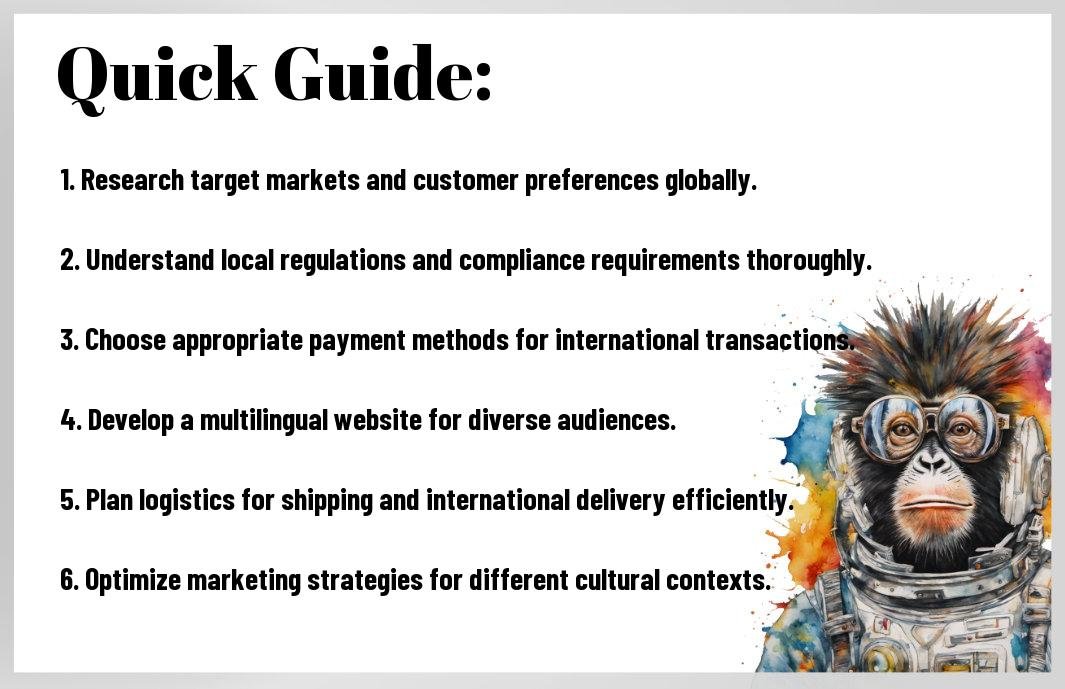You are about to begin on an exciting journey into the world of international eCommerce, where opportunities and challenges await. Understanding how to navigate global markets can elevate your business, but it also requires careful consideration of cultural differences, legal regulations, and consumer behaviors. This guide will equip you with necessary tips and strategies to help you venture confidently into international sales while avoiding common pitfalls that can jeopardize your success. Get ready to expand your horizons and unlock new potential for your online business!
Key Takeaways:
- Understanding Regulations: Familiarize yourself with the various legal frameworks and compliance requirements in different countries to avoid potential pitfalls.
- Market Research: Conduct thorough competitive analysis and understand cultural differences to tailor your products and marketing strategies effectively.
- Logistics & Fulfillment: Establish reliable shipping and delivery networks that can help you efficiently manage supply chains across international borders.
Understanding International eCommerce
Before delving into the intricacies of international eCommerce, it’s vital to grasp the core concepts and frameworks that govern this global marketplace. As you’re looking to expand beyond your domestic borders, understanding the various international eCommerce models can help you make informed decisions that align with your business goals.
Types of International eCommerce Models
Any international eCommerce setup can generally be categorized into a few distinct models. Each comes with its own set of advantages and challenges that you need to navigate carefully.
| Model | Description |
|---|---|
| Direct Selling | Selling your products directly to consumers in foreign markets via websites or social media. |
| B2B eCommerce | Focusing on sales between businesses, often involving bulk orders and custom agreements. |
| Marketplace Platforms | Utilizing established platforms like Amazon or eBay to reach international customers without significant upfront investment. |
| Franchising | Allowing local entrepreneurs to operate under your brand in exchange for fees and royalties. |
| Dropshipping | Collaborating with suppliers who handle inventory and shipping, allowing you to focus on marketing. |
Recognizing which model suits your business will set a strong foundation for your international presence and help you address unique market demands effectively.
Benefits of Expanding into Global Markets
Expanding your eCommerce business into global markets offers numerous potential benefits that can significantly enhance your overall growth. By tapping into international audiences, you not only diversify your income streams but also mitigate risks associated with relying solely on your local market. This can be particularly beneficial if your domestic market experiences economic fluctuations.
Another major advantage is the access to a broader customer base, giving you the ability to scale your operations effectively. Operating internationally can also lead to increased brand recognition and potential partnerships with local firms, which can further accelerate your expansion efforts. Importantly, staying informed about different consumer preferences across regions allows you to tailor your offerings, resulting in strengthened customer relationships and increased loyalty.
International eCommerce is not without its challenges, however. Adapting to different regulations, payment preferences, and logistical considerations are critical to your success. Thus, proper planning and strategic execution are your keys to winning in the global arena.


Preparing for International eCommerce
Some aspects of preparing for international eCommerce can seem overwhelming, but when approached systematically, they become manageable. Key factors to consider before going global include understanding your target market, local regulations, payment methods, logistics, and cultural differences. Each market comes with its own nuances, and failing to recognize them can result in costly errors. Here are a few critical points to think about:
Key Factors to Consider Before Going Global
- Market Research: Identify the demand for your products or services.
- Legal Compliance: Familiarize yourself with local laws and regulations.
- Shipping and Logistics: Establish a reliable distribution network.
- Payment Options: Provide local payment methods to enhance convenience.
- Cultural Sensitivity: Acknowledge and respect cultural differences in advertising and business practices.
After considering these factors, you’ll have a strong foundation upon which to build your international eCommerce strategy, aligning your business objectives with the realities of global markets.
Researching International Markets and Competition
Factors impacting your success in international eCommerce highly depend on how well you research international markets and competition. Global expansion means that you are not only competing with local businesses but also with international companies vying for the same customer base. Thoroughly understanding market demand, existing competition, and consumer behavior in each target market is vital for identifying opportunities and challenges. Make sure to leverage data analysis tools and resources that provide insights into potential markets.
Global competitors can have established relationships and brand loyalty that you will need to overcome. It is also vital to keep an eye on pricing strategies, marketing techniques, and distribution methods used by competitors. Arm yourself with this information to develop a robust entry strategy that clearly defines how you can appeal to your target customers.
With a well-thought-out plan based on comprehensive research, you can avoid common pitfalls and position your business favorably in a new market.
Understanding Cultural and Language Barriers
Understanding cultural and language barriers is critical when entering international eCommerce. These factors can significantly affect how your brand is perceived and accepted by local consumers. Doing business in a new country means adapting to distinct cultural norms, values, and buying behaviors that may diverge significantly from what you are accustomed to. This can pose challenges, especially if your marketing messages, product descriptions, and customer service lack cultural sensitivity.
Plus, consider employing native speakers for translations and customer interactions to avoid miscommunication and to increase trust among consumers. It is important to recognize that even slight missteps in cultural understanding can be viewed negatively and may harm your brand’s reputation. Make cultural adaptation a priority to build authentic relationships with international customers.
Developing a strategy to recognize and respect these differences can lead to more positive customer experiences and reinforce your brand’s credibility.
Setting Up Your International eCommerce Store
To successfully launch an international eCommerce store, you must take a series of important steps that cater to a global audience. These preparations will not only enhance your online presence but also ensure that customers from different regions have seamless shopping experiences. Each aspect, from your website’s design to payment options, plays a crucial role in setting the foundation for your global business.
Step-by-Step Guide to Creating a Global-Friendly Website
Even though you may already have an eCommerce website, adapting it for international audiences involves more than just translation. You need to optimize it for different languages, cultures, and user preferences. Below is a simplified guide to make your website more appealing and accessible to global customers:
| Steps | Description |
|---|---|
| Select a Multilingual Platform | Choose a platform that easily supports multiple languages and offers translation features. |
| Implement Local Currencies | Allow customers to view prices in their currency, enhancing their shopping experience. |
| Optimize for Local Preferences | Research cultural norms and shopping habits to tailor your website design accordingly. |
| Mobile Responsiveness | Ensure your site is mobile-friendly, as many international consumers shop on their devices. |
Moving forward, your website must also offer various contact options, including international phone numbers and chat support, to accommodate customers in different time zones. The more user-friendly your site, the more likely you are to convert visitors into loyal customers.
Choosing the Right Payment Gateways and Logistics Providers
On your path to going global, selecting the correct payment gateways and logistics providers is pivotal. Not all payment options are available in every country, and a limited selection can lead to abandoned carts. Additionally, it’s crucial to provide reliable shipping options to enhance customer trust and satisfaction. Always research which services are popular in your target regions and consider partnering with multiple providers for flexibility.
Right now, you should focus on integrating payment gateways that support multiple currencies and provide local payment methods, such as regional credit cards or services like PayPal and Alipay. These options will not only ease the checkout process for your customers but will also give your store an edge over competitors, increasing your chances of success.
Configuring Taxes and Currency Conversion
An often-overlooked aspect of international eCommerce is the configuration of taxes and effective currency conversion. You must be aware of tax regulations in the countries where you operate to avoid legal complications. This includes understanding customs duties and whether you need to register for or charge VAT for international orders.
Additionally, providing an accurate currency conversion feature will ensure transparency with your customers. If they see a price in their currency, they can make informed purchasing decisions without fearing hidden costs. It’s important to keep your conversions up-to-date in real time to reflect changes in exchange rates.
StepbyStep, you can integrate tax calculation tools and currency converters into your eCommerce platform, allowing for a more automated process. This approach not only saves you time but also improves user experience, which ultimately helps in building trust with your international clientele.
Marketing and Promotion Strategies
All successful international eCommerce ventures require a well-thought-out marketing and promotion strategy to reach your target audience effectively. With the diversity of cultures, languages, and consumer behaviors across different countries, tailoring your campaigns is crucial. You’ll want to consider not only the messaging but also the platforms that resonate with specific demographics. Ensure that your content is culturally relevant and appealing, as a one-size-fits-all approach is often ineffective in the global marketplace.
Tips for Creating Effective International Marketing Campaigns
To craft impactful international marketing campaigns, start by conducting thorough market research to identify the preferences and habits of your target audience in each region. Localization is key; this means adapting your marketing materials—such as language, visuals, and cultural references—to suit local tastes. Here are some important tips:
- Understand local consumer behavior and market trends.
- Utilize local partnerships to enhance credibility.
- Optimize campaigns for mobile devices, as mobile commerce is growing worldwide.
- Monitor campaign performance to adapt your strategies in real-time.
Perceiving cultural nuances and consumer preferences clearly will set your marketing efforts apart from competitors in the international arena.
Leveraging Social Media and Influencer Marketing Globally
If you want to expand your reach effectively, leveraging social media and influencer marketing is a powerful strategy. Different platforms like Instagram, Facebook, and TikTok have varying levels of popularity in different regions, so you’ll need to select the right channels that align with your demographic. Collaborating with local influencers can help you tap into established trust and rapport with their audiences, giving your brand the authenticity it needs to succeed in diverse markets.
For instance, targeting micro-influencers who have smaller, highly engaged followings can often lead to a more cost-effective reach than working with high-profile influencers. Remember to ensure that their brand aligns with your values and that they genuinely connect with their followers. Building a community around shared interests and values will foster stronger relationships with potential customers.
Understanding SEO for International Markets
Now, understanding SEO for international markets is vital for ensuring that your online presence reaches global consumers. A solid SEO strategy should involve researching keywords relevant to each region and optimizing your website accordingly. This means not only translating content but also localizing keywords to ensure that people in different countries can find your products easily. Engaging with local search engines and incorporating regional slang or terminology can also significantly improve your visibility.
It’s important to consider that SEO practices can vary widely between different countries, and what works in one region may not in another. Monitoring search engine trends locally can reveal new opportunities. Keeping a close eye on your site’s performance via tools like Google Analytics will provide insights into what’s working and what’s not—allowing you to adjust your strategies swiftly.
Navigating Logistics and Shipping
Not every shipping method will suit your specific needs as you venture into the world of international eCommerce. Careful consideration of logistics is necessary to maintain customer satisfaction and ultimately succeed in global markets. The choice of shipping carrier plays a crucial role in your operational efficiency, and there are multiple factors to weigh before making a decision.
Factors to Consider When Choosing a Shipping Carrier
To start, you must evaluate various shipping carriers based on factors such as cost, speed, and reliability. Comparing these elements can help you make a more informed decision. It’s also important to consider the regions you intend to serve and the shipping options available for those areas. A carrier that excels in one region may not deliver the same quality in another.
- Delivery times across different carriers
- Shipping costs influence your profit margins
- Customer service and support offered by the carrier
- Tracking options for your shipments
Assume that you conduct thorough research and compare various shipping options; this diligence will pay off in improved customer satisfaction. The right carrier can turn shipping into a competitive advantage, while the wrong choice can hinder your business growth.
Understanding Customs and Import Regulations
You must familiarize yourself with the relevant customs and import regulations for each country you intend to sell in. Navigating this complex landscape is crucial not only for smooth transactions but also for avoiding costly penalties. Customs regulations often dictate documentation requirements, potential tariffs, and even prohibited items that could derail your shipping endeavors.
Consider investing time in understanding the shipping regulations of both your home country and your international market destinations. Each country’s requirements can vary significantly; some may have stringent rules regarding what can be imported, while others may be more lenient. A good grasp of these regulations will save you time, money, and frustration down the line, ensuring your products arrive at their destination without delay.
Managing Returns and Refunds Internationally
Some challenges arise when you need to manage returns and refunds from international customers. The differences in return policies, shipping costs, and exchange rates can complicate the process. You must establish a clear, customer-friendly return policy that accounts for potential international complexities. It’s smart to communicate these policies clearly on your website and perhaps even consider offering a local return address if feasible.
Logistics play a critical role in your return process as well. A strong partnership with your shipping carrier can streamline returns, making it easier for your customers and yourself. Additionally, consider how you will handle refunds and customer inquiries. Having a system in place to manage these scenarios will strengthen your brand’s reputation and build trust with your international clientele.
Managing International eCommerce Operations
Many entrepreneurs are eager to tap into global markets, yet managing international eCommerce operations can feel overwhelming. It requires careful planning, strategic partnerships, and an understanding of the unique challenges that arise in different countries. As you venture into international waters, it’s crucial to address key operational components that will set your business up for success.
Pros and Cons of Outsourcing Fulfillment and Logistics
With the increasing complexity of international shipping, one option that many businesses consider is outsourcing fulfillment and logistics. This decision comes with both benefits and downsides that you need to carefully evaluate.
| Pros | Cons |
|---|---|
| Access to specialized expertise and resources | Higher costs compared to managing in-house operations |
| Faster shipping times with local partners | Less control over shipping processes and customer experience |
| Scalability to meet varying demand | Potential disconnect in brand identity |
| Reduced operational burden on your team | Risk of delays due to third-party issues |
| Better handling of international regulations | Communication challenges across time zones |
Managing Inventory and Supply Chain Across Borders
On the international stage, effective management of inventory and supply chains is paramount to your success. You will need to consider factors such as varying lead times, demand fluctuations, and local regulations that can impact how you source products and fulfill orders. Developing robust relationships with suppliers and logistics partners in your target markets helps create a resilient supply chain that can adapt to changes and challenges.
Outsourcing elements of your supply chain can significantly streamline operations, but you should be cautious. It’s critical to maintain a strong grasp of methods and metrics to assess performance, given the added difficulty of managing these operations remotely. You’ll want to implement tools like inventory management software that can provide real-time data, enabling better forecasting and reducing the risk of stockouts or overstock situations.
Ensuring Compliance with International Regulations
Ensuring that your business complies with international regulations is not only a legal obligation but also a critical factor in maintaining your brand integrity. As you expand abroad, familiarize yourself with import/export laws, sales tax regulations, and consumer protection requirements in each market. Non-compliance can lead to hefty fines, restrictions, or damage to your reputation.
Additionally, you should stay updated on changing regulations within different countries, as they can vary widely and evolve rapidly. Engaging with local legal counsel or compliance experts can be an invaluable resource, ensuring that your business navigates the complex regulatory landscape safely and efficiently.
A keen eye on compliance will also benefit your supply chain management. By proactively addressing regulatory issues, you can avoid unexpected disruptions and ensure a smoother operational flow across borders.
Final Words
Taking this into account, your journey into the world of international eCommerce can be both rewarding and challenging. As you expand your business beyond local markets, understanding the nuances of global trade, from cultural sensitivities to regulatory requirements, is crucial. By continually educating yourself and seeking resources that can guide you through this complex terrain, you’ll be better equipped to make informed decisions that will lead to your success. Whether it’s refining your supply chain, understanding your customer’s preferences, or mastering international shipping logistics, every step you take will bring you closer to thriving in the global marketplace.
Be mindful of, as you commence on this venture, you’re not alone. There are numerous resources available to assist you, such as the invaluable insights provided in [E-Commerce International Shipping: A Starter’s Guide for …](https://passportshipping.com/blog/ecommerce-international-shipping-a-starters-guide-for-going-global/). By leveraging these tools and remaining adaptable, you’ll enhance your competitive edge and ensure that your international eCommerce business flourishes in today’s interconnected world. Stay informed, be proactive, and watch your business soar across borders!
FAQ
Q: What is ‘Navigating Global Markets – A Beginner’s Guide to International eCommerce’ about?
A: ‘Navigating Global Markets – A Beginner’s Guide to International eCommerce’ serves as a comprehensive resource for newcomers to international eCommerce. It covers critical topics such as understanding different global markets, setting up online operations, navigating regulatory requirements, managing logistics, and leveraging digital marketing strategies to reach international customers effectively.
Q: Who is the target audience for this guide?
A: This guide is primarily aimed at entrepreneurs, small business owners, or individuals interested in expanding their existing online businesses into global markets. It is designed to cater to those who may lack extensive prior knowledge in international eCommerce, making it accessible for beginners.
Q: What are some key topics covered in the guide?
A: Key topics covered include market research techniques for identifying potential international markets, understanding cultural differences in consumer behavior, compliance with international trade laws and regulations, payment processing options for cross-border transactions, and strategies for effective international shipping and returns management.
Q: How can I benefit from reading this guide?
A: By reading this guide, you’ll gain valuable insights and practical tips on how to successfully launch and operate an international eCommerce business. It will equip you with the knowledge needed to make informed decisions about market entry, optimize your online presence for diverse audiences, and establish effective operations to handle international sales and customer service.
Q: Are there any resources provided at the end of the guide?
A: Yes, the guide includes various resources such as links to helpful websites, suggested reading materials, tools for market analysis, and templates for creating a viable international eCommerce business plan. These additional resources aim to support you as you apply the concepts learned and work towards successfully engaging in global markets.










